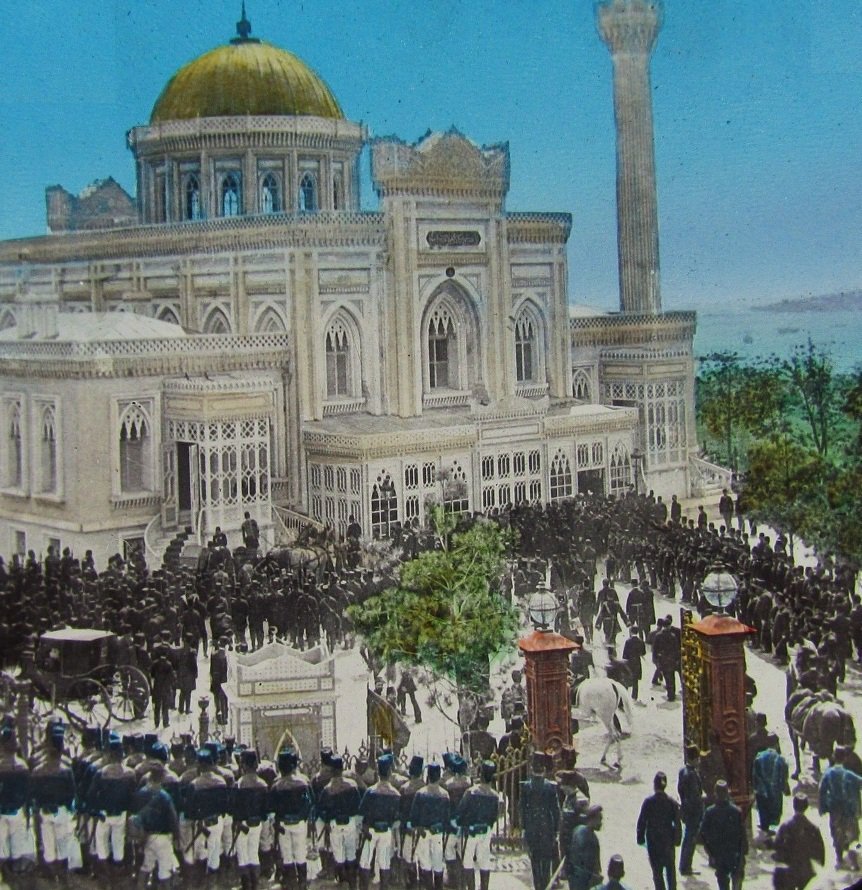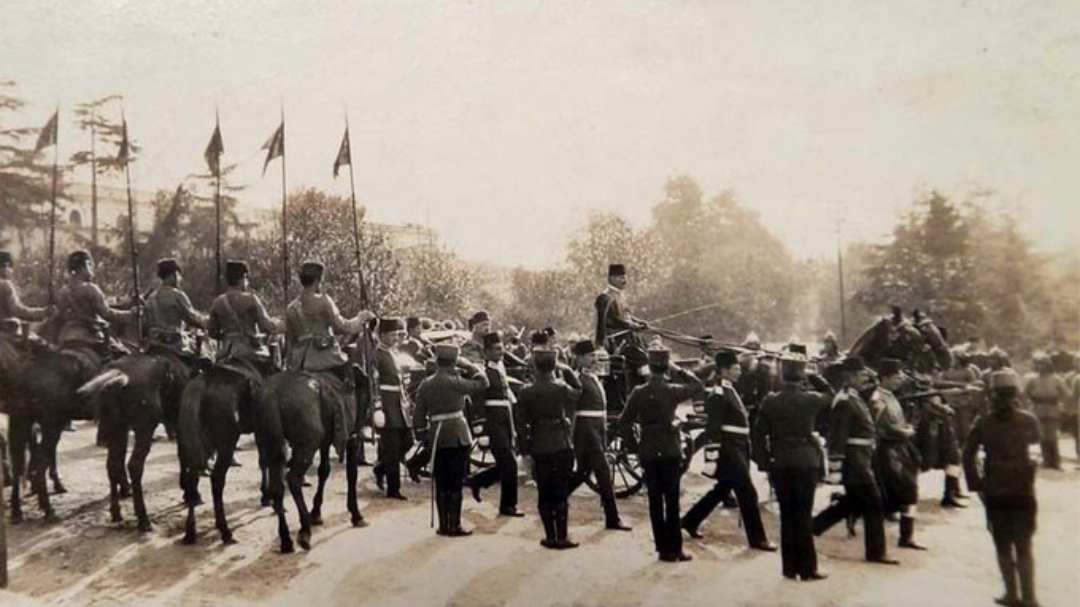.jpg)
WHAT IS ‘THE FIRE PETITION’ IN OTTOMANS
In the Ottoman Empire, anyone with complaints against civil servants could submit a petition to the sultan as he went to the mosque for attending Friday prayers. This was regarded as the last resort.

The Ottoman sultan's visit to the mosque to perform Friday prayers every week was one of the most magnificent ceremonies of imperial life. The very Friday prayer procession, which was called “Cuma Selamlığı" or "Selamlık Resmi,” and, which had set ceremonial rules, was of great importance from a political point of view.
The sultan would go to the mosque in his royal carriage with ceremonial soldiers standing to his left and right as people took to the streets to catch a glimpse of "the most majestic ruler of the time" in flesh. It attracted great interest, not only from locals but also foreigners visiting the country.
Meanwhile, anyone who had a request for the sultan would also gather in the square. For this reason, the Friday procession can be described as one of the most overshadowed scenes in Ottoman history.
Burning like a fire
When the sultan performed the Friday prayer and left the mosque, a special officer (privy secretary) would collect people’s petitions and then present them to the sultan. Occasionally, those in the back row of the crowd would raise a burning piece of straw or a bowl containing a burning rag to indicate that he also had a petition and grab the officer's attention.
Metaphorically, the action would also symbolize that the complainant was burning like fire. In time, this traditional practice became known as the “fire petition” or “burning straw to the head.” Such that, those who claimed that they were subjected to injustice by civil servants would use phrases like “I’ll make a fire petition” or “I’ll burn a straw,” to warn them.

The last resort
The fire petition was not specific to the Friday procession as it could be made whenever the complainant came across the sultan, whether he was visiting the Yalı Mansion, a waterfront mansion that used to be located on the Golden Horn side of Topkapı Palace in Istanbul, facing Galata neighborhood, or at the Alay Mansion, a 16th-century historical building on the outer walls of the Gülhane Park next to Topkapı Palace. This tradition also existed at the time of the Byzantines. Those with complaints against the administration or judges could inform the emperor while he going to the Hagia Sophia Church or any other place.
During the Ottoman era, those who had requests or complaints about the civil servants or claimed he or she was unfairly persecuted or was not satisfied with the judgment of the courts had to apply to the governor first. If they were unable to get an answer from the governor, they could then apply to the Divan-ı Hümayun (Imperial Council) in Istanbul. Since all officials were actually deputies of the sultan, he was seen as an authority that could resolve all problems. The sultan would consider himself responsible for the actions of every officer appointed by him. The petition to the sultan was therefore considered the last resort. Whoever applied to him could find a solution one way or the other. In this regard, no unfair distinction was made based on gender, religion or freedom.

The vigilant ambassador
After being examined by the sultan, the petitions were given to the relevant authorities to be finalized and their results were presented to the sultan. In general, the very petitions were sent to the vizier and then they were closely kept track of. Today’s Ottoman archives are full of such petitions and the edicts written about them.
In 1648, seven English trade galleons brought some goods to Istanbul. According to the trade agreement between the Ottoman Empire and England, 3% customs duty was supposed to be levied on them but they were wrongly charged 6%. In addition, the cost of the goods, which amounted to around 15,000 kuruş (the standard unit of currency in the Ottoman Empire until the mid-19th century, also referred to as piastres) was not paid either. The ship owners were unable to get any results on their complaint applications. They literally didn’t know what to do. Sir Thomas Bendish, then English ambassador in Istanbul, showed them a way. The galleons hoisted the white flag in the middle of the sea in front of the Galata neighborhood. The entire crew lined up on the deck and burned pitches in copper buckets on their heads and started shouting. The very scene was seen from the Topkapı Palace. Immediately, men were sent to the ships to learn what the problem was. Then Sultan Ibrahim fixed the problem and ended the injustice by sending Çavuşbaşı Ibrahim Ağa, a janissary officer working at the palace, to the Grand Vizier Hezarpare Ahmed Pasha.

Last ceremony, last petition
Ottoman Sultan Abdülhamid II's concern and his attention to the empire can be seen from how seriously he took the fire petition tradition. So much so that when people would show their petitions during the Friday procession, a uniformed officer would collect them in a bag and present them to the sultan. He assigned the Ottoman field marshal Osman Nuri Pasha or famously known as Ghazi Osman Pasha to examine these petitions. Abdülhamid II had also allotted him a large flat in the palace for this purpose.
The petition tradition continued until the date the caliphate was abolished and then it disappeared into history. Today, people's petitions to the Turkish Presidency and Parliament can be considered an extension of this tradition.
In Ottoman history, the last Friday procession was held on Feb. 29, 1924. Turkish writer Münevver Ayaşlı recalling the memory said, “I saw the last Caliph (Sultan) Abdülmecid Efendi going to Dolmabahçe Mosque. A crowd of about 30 people including a few princes, a few journalists, and curious people gathered. No classical writers, not even the famous (William) Shakespeare, could write and stage the tragedy of this scene. I can't forget the Caliph's facial expression. He was sorrowful, resolute and resentful... Everyone was confused and nobody realized the gravity of the matter yet... Everyone had a strange opinion that this would never be the truth. But the climax of this drama, and the most pathetic part, was when an old lady, unaware of anything, threw a petition onto the Caliph’s carriage, as was the custom. In other words, in today's terms, a woman from the nation gave a petition to the Caliph. He was such a Caliph whose rights were stripped off, - including even the right of citizenship!”
Three days later after the last procession, the Caliph and the entire Ottoman dynasty were stripped of their citizenship and exiled abroad by the Turkish government.
Önceki Yazılar
-
THE FIRST UNIVERSITY IN THE WORLD WAS FOUNDED BY MUSLIMS3.12.2025
-
WHO BETRAYED PROPHET ISA (JESUS)?26.11.2025
-
IT HAS BEEN MORE THAN 100 YEARS SINCE ITS ABOLITION, BUT... IS THE CALIPHATE BEING REESTABLISHED?19.11.2025
-
GREETINGS TO YOU, O OTTOMAN SANJAK!…12.11.2025
-
ROTHSCHILDS BROUGHT THE END OF THE OTTOMAN EMPIRE!5.11.2025
-
SHEIKH BEDREDDIN, SON OF THE QADI OF SIMAVNA29.10.2025
-
THE ROOTS OF THE ENGLISH POLITICIAN IN TURKEY – THE TRAGIC END OF ALI KEMAL BEY22.10.2025
-
WHERE IS THE RED APPLE?15.10.2025
-
THE ABBASIDS IN ANATOLIA1.10.2025
-
IMAMS AND MUFTIS AS OFFICERS IN THE OTTOMAN ARMY24.09.2025